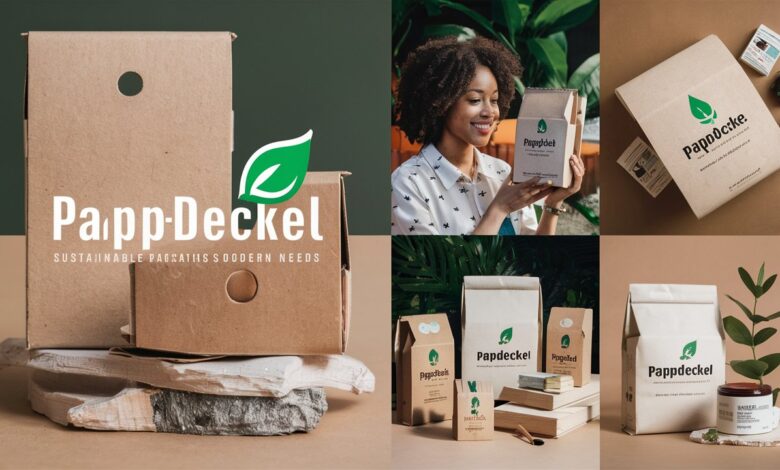Pappdeckel: The Sustainable Solution for Modern Packaging Needs

As global awareness of environmental issues grows, the need for sustainable and biodegradable alternatives to plastic has never been more critical. One such innovation making a quiet but powerful impact is the Pappdeckel—a cardboard or paperboard lid that is increasingly replacing plastic and Styrofoam lids in food and beverage packaging. Originally developed as a practical solution for hot drinks and takeaways in Europe, particularly in Germany, Pappdeckel is now making its way into international markets due to its eco-friendly profile and ease of recycling. This article dives deep into the advantages, applications, and future of Pappdeckel in sustainable packaging.
What is a Pappdeckel?
The term “Pappdeckel” is German and directly translates to “cardboard lid” or “paperboard cover.” It refers to a circular, usually flat piece of thick paper or thin cardboard that acts as a cover for cups, containers, or takeaway food packaging. Unlike its plastic counterparts, Pappdeckel is made from renewable resources and is often compostable or recyclable, depending on the materials and production process. While the idea may seem simple, it represents a fundamental shift toward minimalism and sustainability in packaging.
Pappdeckel comes in various thicknesses and coatings. Some are designed to withstand moisture or heat, while others are purely for covering cold foods. They are commonly used for coffee cups, soup bowls, yogurt containers, and even ice cream packaging. Due to the rise of zero-waste and plastic-free movements, many businesses now offer products with a Pappdeckel instead of traditional plastic covers.
Why Pappdeckel is Better Than Plastic Lids
Plastic lids, while convenient, have become a symbol of the environmental crisis. They often end up in oceans, landfills, and ecosystems where they take hundreds of years to decompose. In contrast, Pappdeckel is biodegradable, renewable, and easily recyclable. Manufacturers can produce them from post-consumer paper, agricultural waste fibers, or virgin pulp certified by the Forest Stewardship Council (FSC). This not only reduces carbon emissions but also cuts down on petroleum use, which is a primary component of plastic.
Moreover, Pappdeckel does not contain harmful microplastics, which have become a pressing concern in global food and water supplies. As consumers become more educated, they actively seek out businesses that demonstrate environmental responsibility. Switching to Pappdeckel is not just a logistical move—it’s a powerful branding tool that tells your customers you care about the planet.
Applications of Pappdeckel in the Food Industry
The food and beverage industry is one of the largest contributors to single-use plastic pollution. In coffee shops, for example, the disposable coffee lid is often overlooked as a source of waste. However, multiply that by millions of daily users and the numbers become staggering. This is where Pappdeckel shines. Coffee chains in Germany and other European countries have already made the switch, and international franchises are beginning to follow suit.
Beyond hot drinks, Pappdeckel is also ideal for soups, smoothies, yogurts, ice creams, and even takeaway meal boxes. Some designs feature ventilation holes to prevent pressure build-up, while others have interlocking grooves for a tight seal. They can be printed with custom logos, which makes them excellent for branding. The adaptability of Pappdeckel makes it a top choice for eco-friendly entrepreneurs looking for packaging that aligns with their values.
Pappdeckel and Circular Economy Principles
In a circular economy, products are designed for reuse, recycling, or composting at the end of their lifecycle. Pappdeckel fits perfectly into this model. Unlike multi-material lids that mix plastic and aluminum (making recycling nearly impossible), Pappdeckel is usually composed of a single material that simplifies waste management. Cities and municipalities that are pushing for circular systems often encourage businesses to adopt paperboard alternatives.
Many Pappdeckel options are home-compostable, meaning users can dispose of them in garden compost without industrial processing. This minimizes waste and promotes local nutrient cycling. When a business chooses to integrate Pappdeckel into its packaging model, it participates directly in a regenerative, closed-loop system that benefits both the economy and the environment.
Challenges and Future Outlook
While Pappdeckel is a promising solution, it is not without challenges. Some products require water-resistant coatings, which may include bioplastics that are not easily biodegradable in every environment. Manufacturers must strive to innovate coatings that are both functional and environmentally safe. Furthermore, the cost of Pappdeckel may be slightly higher than plastic lids in the short term, which can be a barrier for small businesses.
However, with increasing regulation against plastic use—such as the EU’s Single-Use Plastics Directive—the transition toward sustainable alternatives is inevitable. As demand increases and economies of scale kick in, the price of Pappdeckel will continue to drop. Innovations in materials science are also leading to stronger, lighter, and more durable versions of the cardboard lid. It is only a matter of time before Pappdeckel becomes the new industry standard.
Conclusion
The Pappdeckel is more than just a cardboard lid—it is a symbol of a larger shift in consumer consciousness and industry responsibility. As sustainability becomes a core value for both individuals and corporations, packaging solutions like Pappdeckel are gaining momentum. Businesses that embrace this eco-friendly trend will not only reduce their environmental footprint but also gain a competitive edge in a rapidly evolving market. Whether you’re a small café owner, a packaging manufacturer, or an eco-conscious consumer, investing in Pappdeckel is a practical and ethical choice that supports the planet without compromising performance or style.
🙋 FAQ: Frequently Asked Questions About Pappdeckel
Q1: What materials are used to make a Pappdeckel?
A Pappdeckel is typically made from recycled paperboard, virgin pulp, or a blend of organic fibers. Some may have a thin biodegradable coating for heat or moisture resistance.
Q2: Are Pappdeckel lids compostable?
Yes, most are compostable. However, check whether the product is industrial or home compostable, as this affects disposal methods.
Q3: Can Pappdeckel be customized for branding?
Absolutely. Many suppliers offer full-color printing options to add your logo, artwork, or eco-messages.
Q4: How strong are Pappdeckel lids compared to plastic?
While they may not be as rigid as plastic, modern Pappdeckel products are designed to be secure, leak-resistant, and durable for most food and beverage applications.
Q5: Where can I buy Pappdeckel lids in bulk?
Many eco-packaging companies in Europe and online marketplaces like Alibaba or regional distributors offer bulk purchases with customization options.



